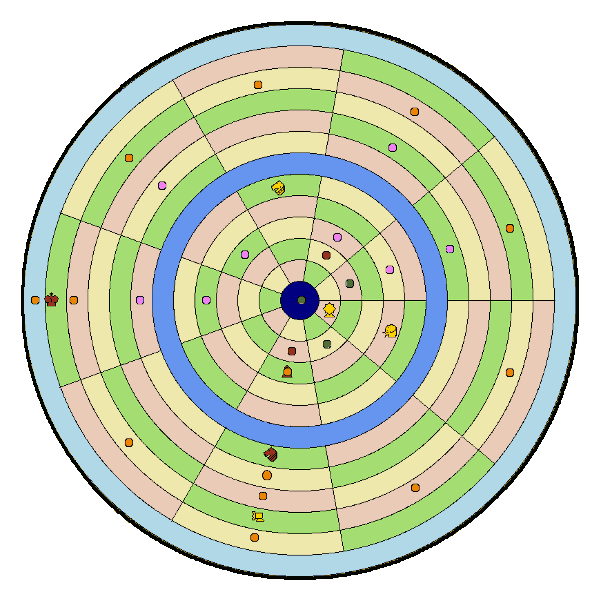Spherical Chinese Chess
Play on a spherical board is a corner of the variant world that seems scarcely to have been explored. There appears to be only a few such variants:
All use pieces from FIDE Chess, and complete the sphere in one of two ways:- Use triangular cells at the poles
- Add a circular cell at the poles. These polar-cells may be 'dead', that is they are not part of the board; or may be 'live' and thus a part of the playing surface
Setup
There are two sides designated gold and red. Gold moves first. Piece positions are based on cells rather than points and the board is a sphere constructed from 92 cells. The starting position is shown in Image 1.
| Image 1 |
|---|
 |
The representation of the spherical board follows that described in
Small Spherical Chess
The light-blue outermost circle is a single cell, the red's pole. It is
connected both orthogonally and diagonally to all the 9 cells in the next inward
circle. Likewise the dark-blue central circle, the gold's pole, is
connected both orthogonally and diagonally to all the 9 cells in the next outward
circle.
The blue circle on the sphere's equator is the river separating Gold's home
hemisphere from yhat of Red's. The palace or fortress for each side includes
that side's pole plus the cells of the next two circles. The poles may also be
referred to as 'thrones'.
Pieces
The pieces are those found in Chinese Chess (XiangQi ) namely:
- General - graphic King : each side starts with 1
- Advisors - graphic Guard : each side starts with 3
- Horses - graphic Knight : each side starts with 3
- Chariot - graphic Rook : each side starts with 3
- Elephants - graphic Elephant : each side starts with 3
- Cannons - graphic 'sideways' Rook : each side starts with 3
- Soldiers - graphic Pawn : each side starts with 6
| Image 2 | |
|---|---|
|
Working from the centre outwards, the Gold King's possible mpves are shown by violet
dots. Note that this King is prevented from moving to the pole cell by the
'facing Kings' rule. Next the Gold Pawns' moves are shown using white dots, and finally the Rook's moves are shown with orange dots. Note that null moves are not permitted. |

|
| Image 3 | |
|
Again, working from the centre outwards, the Gold Guard's possible moves are
indicated by dark-green dots, while the two legal moves for the Gold Elephant are
shown by brown dots.
The Gold Horse's moves are illustrated by violet dots, with the Gold Cannon's moves given as orange dots. |
 |
Rules
Apart from the differences described above the rules of orthodox Chinese Chess apply.
 This 'user submitted' page is a collaboration between the posting user and the Chess Variant Pages. Registered contributors to the Chess Variant Pages have the ability to post their own works, subject to review and editing by the Chess Variant Pages Editorial Staff.
This 'user submitted' page is a collaboration between the posting user and the Chess Variant Pages. Registered contributors to the Chess Variant Pages have the ability to post their own works, subject to review and editing by the Chess Variant Pages Editorial Staff.
By Graeme C Neatham.
Web page created: 2010-01-17. Web page last updated: 2010-01-17
